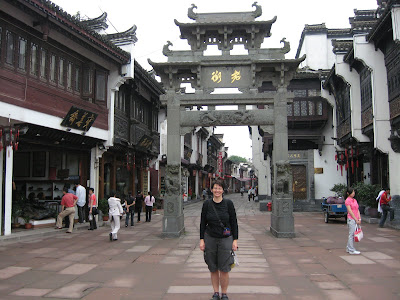I chose to visit Chengkan, dating from the Han Dynasty, because farmers rather than tourists continue to walk along its narrow winding alleys. The fact that it takes a series of four buses to get from Tunxi to Chenkan may be what keeps the tourists away. On the fourth bus, a man deposited a huge bag of Purina feed, paying the driver to deliver it somewhere, and another man boarded with some kind of motor that he and his friend were barely able to heave up the bus steps.
The sign at the entrance of Chengkan said “Welcome to Chengkan for tourism, visit, research, making holiday, lie fallow and sketching.” My aching legs told me that my plan in Chengkan was to lie fallow as much as possible.
Outside the city gates I paused to watch the rice farmers tending their paddies. In several inches of water one man in waders uprooted the densely planted seedlings and stacked them in a basket. Another man, barefoot, re-planted the seedlings, one by one, in the next water-filled paddy while a third man, also barefoot, used a hoe to shore up the clay wall of the paddy. In another paddy, an ox chewed its cud while waiting, hitched to a wooden plow.
In the distance, other farmers performed the same tasks, and one man stood on his wooden plow while a water buffalo pulled it around and around in the paddy.
The farmer who had been pulling the seedlings finished this task and stopped to take a drink. I greeted him with ni hao and offered him a package of Oreos. He refused it but said something to me in Chinese which sounded friendly enough.
The man who had been hoeing put a board over his shoulder and, balancing two huge baskets of wet seedlings, staggered to carry them to the next paddy.
All of the tools, including the plow, hoe, ox yoke, baskets and trays to hold the baskets appeared to be hand made, of wood and reed.
I paid 80 RMB (US $11) to enter the city gate of Chengkan. Villages in China charge a steep entrance fee, double the price of a night in a hostel. 

I had lunch at the village’s only restaurant. The waitress spoke a little English, and asked me if I wanted rice, noodles or dumplings. After I chose rice, she asked me to step into the kitchen and choose a vegetable. Since vegetables are not cooked together, I could only choose one. So I got a huge bowl of plain rice and a plate of cabbage fried with garlic and bother. Together with a beer for the hot day, it was a pretty good lunch. On the way back to Tunxi, two of the four bus drivers remembered me and gleefully helped me get on the right series of buses.
The next day I took a bus to Hongcun, a more touristed but still beautiful village, famous for its Moon Pond. 
I rented the bike solely using gestures and drawings, and amazingly the shopkeeper and I correctly communicated the price, rental period and deposit which would be returned to me.
Anhui is a peaceful respite in bustling China.





















